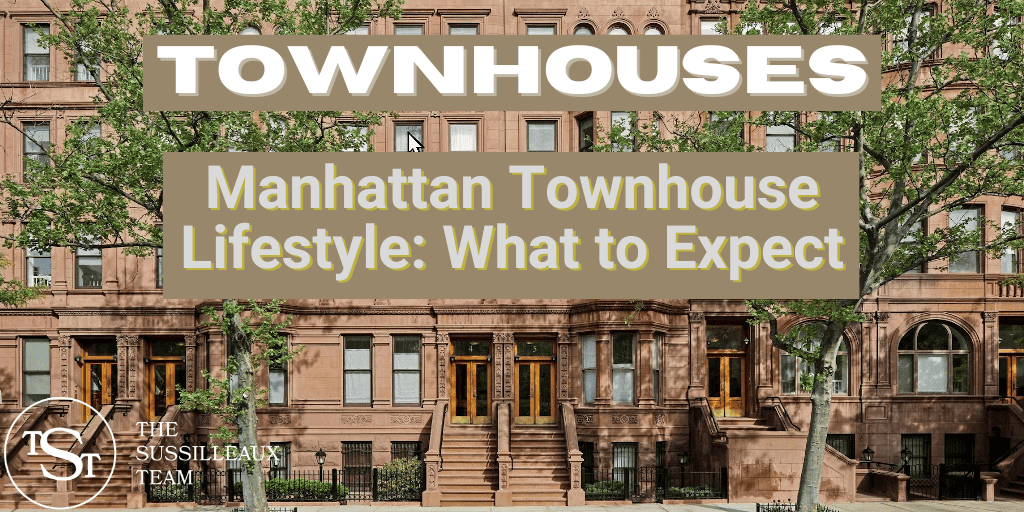Introduction to Manhattan Townhouse Living aND LIFESTYLE
Manhattan townhouses have been an integral part of New York City’s architectural landscape since the 19th century. These elegant, multi-story residences are highly sought after for their unique combination of historic charm and urban convenience.
With over 40 years of experience assisting our real estate clients buy, sell, and rent townhouses, we have experienced the gamut of Manhattan lifestyles from a personal perspective, ranging from multifamily buildings with tenants all the way to grand single-family masterpieces.
In this article, we’ll explore the various types of townhouses, the benefits, and challenges of living in one, and the current state of the Manhattan townhouse market.
What to Expect When Living in a Manhattan Townhouse
Privacy
One of the primary advantages of living in a Manhattan townhouse is the privacy it affords. Unlike apartment living, there are no neighbors above or below you, reducing noise disturbance and enhancing the feeling of having your own personal space within the bustling city. The sense of solitude and tranquility that a townhouse can offer is a highly coveted commodity in a city as densely populated as Manhattan.
Freedom To Do What You Want
When you own a Manhattan townhouse, you have the freedom and autonomy to make the space truly yours. Whether it’s painting the walls your favorite color, renovating the kitchen, or hosting a late-night gathering, you have the liberty to do as you please, within legal and zoning limitations, of course. This freedom to express yourself and live life on your terms is one of the most appealing aspects of townhouse living.
Vertical Living – Many Floors
Living in a Manhattan townhouse often means embracing a multi-story lifestyle. With multiple floors, townhouses offer a sense of spaciousness and separation of living areas, which can be particularly appealing for families or people who work from home. However, keep in mind that navigating stairs will become a part of your daily routine, which might not be suitable for everyone.
You’re Typically on a Quiet Street
Manhattan townhouses are typically located on residential streets, which are generally quieter than the city’s major thoroughfares. This can provide a peaceful retreat from the hustle and bustle, enhancing your quality of life. However, quieter doesn’t necessarily mean silent, and city noises can still permeate, particularly in older townhouses with less insulation.
Case Study: Living on an avenue
In Manhattan avenues are main north-south thoroughfares that are typically lined with large residential and/or commercial buildings. There are however some remaining townhouses from yesteryear sprinkled in among the giants. Unfortunately, even though it may be a private home, it’s hard to ignore your towering neighbors and busy street.
I had a client who agreed to look at one such building. While the building was nice, she couldn’t get past the location, and didn’t consider submitting a bid for the property.
That property languished on the market for over 4 years and never sold despite aggressive price reductions.
Private Outdoor Space
Many Manhattan townhouses come with the coveted amenity of private outdoor space. Whether it’s a small garden, rooftop terrace, or a rear courtyard, these spaces provide a rare opportunity to enjoy the outdoors without leaving your home. This can be especially valuable in a city where public outdoor space can be crowded.
PRO TIP: Outdoor space sells! It is one of the main attractions we notice with our buyers. If you are selling a townhouse, don’t neglect upgrading your garden. It makes a big difference in property value!
Parking is Problematic
However, one drawback of living in a Manhattan townhouse is the potential parking issue. While some townhouses come with private garages, most don’t. Street parking can be scarce and subject to restrictions, and nearby garages often come with steep monthly fees. If you own a car, it’s essential to consider the logistics and costs of parking.
You Are Responsible For All Maintenance And Upkeep
As a townhouse owner, all maintenance and upkeep responsibilities fall squarely on your shoulders. This includes everything from minor repairs to major system breakdowns. While this means you have full control over how issues are addressed, it also requires time, money, and a level of home maintenance knowledge.
Multifamily Homes Can Provide Additional Income
If your Manhattan townhouse is a multifamily dwelling, it can offer the added advantage of potential rental income. Renting out a floor or a unit in your townhouse can help offset mortgage payments and maintenance costs. However, becoming a landlord comes with its own set of responsibilities, and the legal, financial, and practical implications need to be carefully considered.
In our experience as professional real estate brokers we see situations where this works out well for the owner, but there are a lot of moving parts when it comes to being a landlord.
While we hop this gives you some ideas, please consider reaching out to us directly if you’re interested in finding out more details about generating extra income by renting units in your building. You can reach us HERE.
Types of Manhattan Townhouses
Historic Townhouses
Manhattan boasts a diverse array of historic townhouses, each with its own distinct architectural style:
- Federal style: These early 19th-century townhouses feature simple, symmetrical facades and refined details, reflecting the influence of English Georgian architecture.
- Greek Revival: Popular in the mid-19th century, Greek Revival townhouses are characterized by their classical columns, pediments, and ornamental cornices.
- Italianate: This mid-19th-century style is distinguished by its decorative brackets, arched windows, and elaborate cornices.
- Brownstone: Named for the reddish-brown sandstone used in their construction, brownstones are synonymous with Manhattan townhouse living and feature intricate carvings and ornate ironwork.
Modern Townhouses
In recent years, architects and developers have introduced contemporary townhouses to Manhattan, incorporating:
- Cutting-edge designs: These townhouses often feature open floor plans, floor-to-ceiling windows, and sleek finishes.
- Green and sustainable features: Solar panels, green roofs, and energy-efficient systems are increasingly common in new townhouse construction.
Renovated and Converted Townhouses
Many historic townhouses have been thoughtfully updated to accommodate modern lifestyles:
- Combining historic charm with modern amenities: Renovations often preserve original details while adding state-of-the-art kitchens and luxurious bathrooms.
- Loft-style living: Some townhouses have been converted into open, airy lofts with high ceilings and industrial-inspired design elements.
The Benefits of Living in a Manhattan Townhouse
Privacy and Exclusivity
Townhouse living offers unparalleled privacy and exclusivity in the heart of the city:
- Single-family home experience: Townhouses provide the independence and autonomy of a detached home within an urban setting.
- Separate entrances and private outdoor spaces: Enjoy the luxury of a private entrance and personal outdoor areas, such as gardens, terraces, or rooftops.
Unique Architectural Features
New York City townhouses are celebrated for their distinctive architectural details:
- Historic craftsmanship: Original moldings, fireplaces, and woodwork add character and charm to these storied residences.
- Modern design elements and customizations: Contemporary townhouses and renovated properties often include custom finishes and innovative design features.
Autonomy and Freedom
This is your property – no condo or co-op board, and as long as you adhere to the city’s building codes and other regulations, you can do what your want.
- You own the entire building, not just a unit in a larger building.
- There is no condo or co-op board and their associated rules and regulations
- You have the freedom to configure the home the way you want to.
Spacious Living
Townhouses are known for their generous living spaces:
- Multiple floors and expansive layouts: The vertical layout provides ample square footage for living and entertaining.
- Flexible living spaces: Townhouses often feature versatile rooms that can serve multiple purposes, such as home offices, gyms, or guest suites.
The Challenges of Manhattan Townhouse Living
Maintenance and Upkeep
Owning a townhouse comes with its share of maintenance responsibilities:
- Historic property upkeep: Preserving a historic townhouse requires regular attention to structural and cosmetic details.
- Costs associated with maintaining a townhouse: Be prepared for ongoing expenses, such as insurance, property taxes, and utilities.
Limited Amenities
Townhouses often lack the amenities found in luxury condominiums:
- Comparing townhouse living to luxury condos: Townhouses typically do not offer doormen, fitness centers, or swimming pools.
- Creating community within a townhouse neighborhood: To compensate for limited amenities, townhouse residents can seek out nearby parks, fitness centers, and social clubs to foster a sense of community.
Accessibility and Mobility
Multi-level living presents certain challenges for some residents:
- Navigating stairs: Townhouses often have multiple flights of stairs, which can be difficult for those with mobility issues.
- Installing elevators or stairlifts: While some townhouses can accommodate elevators or stairlifts, these upgrades can be costly and may require extensive renovations.
PRO TIP: Elevators are sometimes installed in larger townhouses, easing the burden of vertical living. We have personally experienced many townhouse elevators ranging from some so small they can barely accommodate one person, to some that can easily fit 3 people and move quickly between floors. Two points to consider are: 1. Do you have the space to install a vertical shaft without unduly affecting the floor plan and livability of your home? And 2. You must consider the front stoop, (if there is one). Can you access the elevator directly from street level? If not, is it acceptable to climb/descend stairs from the sidewalk into your building?
The Manhattan Townhouse Market
Pricing and Affordability
Manhattan townhouses can range dramatically in price:
- Townhouse prices: Factors such as location, size, and architectural style influence the value of a townhouse, with prices ranging from the low millions to tens of millions of dollars.
- Influential factors: Other considerations, such as proximity to public transportation, schools, and parks, can also affect a townhouse’s value.
Buying and Renovating Process
Finding the perfect townhouse and making it your own can be a rewarding experience:
- Tips for finding the right townhouse: Work with an experienced real estate agent who specializes in townhouses and carefully consider your desired location, budget, and architectural preferences.
- The role of architects and designers: Collaborate with architects and interior designers to bring your vision to life, whether you’re restoring a historic property or updating a modern townhouse.
Trends in Manhattan Townhouse Sales
The townhouse market has experienced notable shifts in recent years:
- The impact of COVID-19: The pandemic has led some buyers to prioritize privacy and space, increasing the demand for townhouses.
- Resurgence of interest in townhouse living: As city dwellers seek more room to work and entertain at home, townhouses have become increasingly popular for their spacious layouts and unique features.
Markets always move, and it’s critical to understand the current market. Leverage our professional expertise by reaching out to us for an explanation of where the Manhattan townhouse market is, and where wit think it’s going. Contact Michael and Dina Sussilleaux
Iconic Manhattan Townhouse Neighborhoods
Upper East Side
This affluent neighborhood is renowned for its historic townhouses:
- Architectural styles and landmarks: The Upper East Side boasts a mix of Federal, Greek Revival, and Beaux-Arts townhouses, as well as iconic landmarks such as the Frick Collection and the Metropolitan Museum of Art.
- Notable townhouse residences: Prominent figures, such as the Roosevelts and the Astors, once called the Upper East Side home.
Upper West Side
This vibrant neighborhood offers classic brownstones and proximity to Central Park:
- Brownstone-lined streets: The Upper West Side is famous for its picturesque rows of well-preserved brownstones.
- Central Park appeal: Living near the city’s most iconic park provides easy access to outdoor recreation, cultural events, and scenic views.
Greenwich Village and West Village
These historic neighborhoods are steeped in artistic and cultural heritage:
- Artistic enclaves: The Village has long been a haven for artists, writers, and musicians, giving the area a bohemian and creative atmosphere.
- Famous townhouse residents: Past and present residents include Bob Dylan, Edna St. Vincent Millay, and Julianne Moore.
Conclusion
Manhattan townhouse living offers a unique and desirable lifestyle, blending historic charm with urban convenience. The variety of architectural styles, spacious layouts, and exclusive features make townhouses an attractive option for discerning homebuyers seeking privacy and character in the heart of the city.
Take advantage of our experience and expertise in the world of Manhattan townhouses, and let’s discover how we can help you meet your real estate goals! Reach out to Michael and Dina Sussilleux
Further reading
You can return to The Complete Guide to Manhattan Townhouses, or go to the preceding article: The Advantages of Living in a Manhattan Townhouse, or move on to the next article in the Living in a Manhattan Townhouse Section: Manhattan Neighborhoods with the Best Townhouses
Frequently Asked Questions (FAQs)
How much does a Manhattan townhouse typically cost?
Manhattan townhouse prices typically begin at $2,000,000 on the low end and range to well over $20,000,000 on the high end, depending on factors such as location, size, and architectural style.
How does townhouse living compare to living in a condo or co-op?
Townhouse living offers more privacy, autonomy, and spaciousness compared to condos and co-ops. However, townhouses usually lack the amenities found in luxury condos, such as doormen, fitness centers, and pools. Townhouses also require more maintenance and upkeep, as owners are responsible for the entire property.
What are the most common architectural styles of townhouses in Manhattan?
Some of the most common architectural styles include Federal, Greek Revival, Italianate, and Brownstone. Each style has its own distinct characteristics and historical roots.
Can I rent a Manhattan townhouse instead of buying one?
Yes, some Manhattan townhouses are available for rent. Renting a townhouse can be a great option for those who want to experience townhouse living without committing to homeownership.
How do I find a Manhattan townhouse that’s currently for sale?
To find a townhouse for sale, work with experienced real estate brokers like Michael and Dina Sussilleaux who specializes in Manhattan townhouses. They will have access to the latest listings and can guide you through the buying process.





